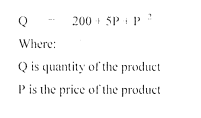TUESDAY: 22 May 2018. Time Allowed: 3 hours.
Answer any FIVE questions. ALL questions carry equal marks.
QUESTION ONE
1. Discuss live negative effects of inflation in an economy. ( 10 marks)
(b) Explain live conditions that could favour effective use of price discrimination in an economy. ( 10 marks)
(Total: 20 marks)
QUESTION TWO
1. Examine our determinants of money supply in an economy. (8 marks)
2. Explain six reasons why a country might impose international trade restrictions. (6 marks)
3. Analyse three roles of International Monetary Fund (IMF) to member countries. (6 marks)
(Total: 20 marks)
QUESTION THREE
1. The demand of a certain product is represented by the following function:

Required:
Determine the point elasticity of demand at P- Sh.20. (5 marks)
Interpret your result in (a) (i) above. (1 mark)
2. Suggest four reasons why wages in the agricultural sector tend to be lower than wages in the industrial sector. (4 marks)
3. With the aid of a well labelled diagram, explain a normal profit making firm under oligopoly in the short-run. (5 marks)
4. Highlight live determinants of economic development in a country. (5 marks)
(Total: 20 marks)
QUESTION FOUR
1. With the aid of a well labelled diagram, explain the law of diminishing marginal utility. (6 marks)
2. Outline four properties of indifference curves. marks)
3. Discuss five ways in which inflation might cause unemployment in an economy. ( 10 marks)
(Total: 20 marks)
QUESTION FIVE
1. Explain the term “partial equilibrium- as used in economics. (2 marks)
2. Suggest three methods that the government of a country might adopt to strengthen its currency. (3 marks)
3. Explain five differences between the “quantity theory of money” and the “liquidity preference theory of money”. (10 marks)
4. With the aid of a diagram, explain why isoquants are negatively sloped. (5 marks)
(Total: 20 marks)
QUESTION SIX
1. With the aid of well labelled diagrams, distinguish between “price floors” and “price ceilings”. (8 marks)
2. In a hypothetical economy X, autonomous consumption equals to 800 and the marginal propensity to save equals to 0.25.
Required:
Formulate the consumption function. (2 marks)
If the level of investment increased by Sh.1,000 million, determine the change in equilibrium national income. (4 marks)
3. With the help of a diagram, justify why the condition that marginal revenue equals to marginal cost (MR = MC) is only a necessary but not a sufficient condition for maximisation. (6 marks)
(Total: 20 marks)
QUESTION SEVEN
1. Highlight five negative effects of unemployment in an economy. (5 marks)
2. Summarise five consequences of wage control. (5 marks)
3. The demand and total cost functions for a hypothetical firm are represented as follows:

Required:
- The marginal cost function. (2 marks)
The average fixed cost function. (2 marks)
The marginal revenue function. (2 marks)
The profit maximising level of output. (4 marks)
(Total: 20 marks)